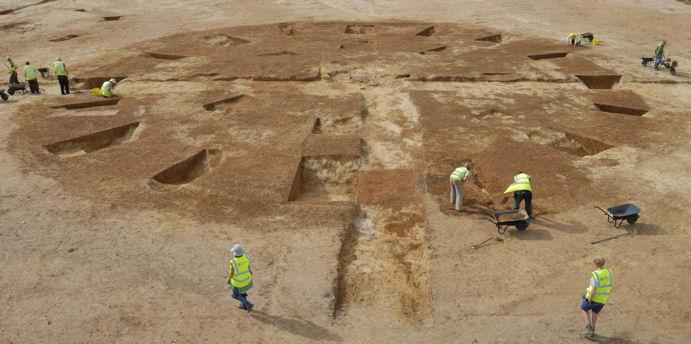
There were over 60 participants at this meeting of the Local History Group, when Alison Dickens, senior project manager at the Cambridge Archaeological Unit, gave a talk about the excavation at Trumpington Meadows. This has revealed a rich and varied landscape above the floodplain of the River Cam, with evidence from the Neolithic, Iron Age and Saxon periods. The remarkable discoveries included the burial of a young Saxon woman, laid on a bed and wearing a beautiful gold and garnet cross, one of the earliest expressions of post-Roman Christianity found in England. Report by Andrew Roberts.
Alison Dickens opened her talk by saying that the Trumpington Meadows excavation had been one of the most interesting and exciting projects in her career. The team had started work in 2006 by identifying areas of interest. The full excavation was carried out from June 2010 to April 2011. This was a complex landscape: there were Roman sites along the river corridor and pre- and post-Roman sites in the land being developed for housing and it was the latter that was the focus for the work. Before the excavation, it had been expected that the main evidence would be Iron Age but the outcome was much more complex.
Three areas were identified for excavation:
• ‘A’ at the northern end of the housing development (south of Anstey Hall Farm and the Church);
• ‘B’ in the centre of Phase I of the development;
• ‘C’ to the south west of Phase I of the development (west of the Park & Ride site and the John Lewis building, including the subsequent location of Trumpington Meadows Primary School).
Neolithic and Bronze Age
Alison Dickens said that Area C included two circular burial monuments (ring ditches), which had been assumed to be Bronze Age but were actually much older, from the Neolithic period. There were the remains of 3 or 4 individuals in the centre of the larger circular monument, buried at different times in the Late Neolithic (c. 3600-2200 BC). There was an outer ditch, Early Bronze Age, with Beaker pottery, antler picks and an arrow head. There was another Neolithic or Bronze Age burial in area A of a young female and a male, with Beaker pottery.

Iron Age
There were Iron Age enclosures in Areas A and B, with pottery from 500-300 BC, and a burial and a large number of Iron Age pits in Area C. There was a ditch to the east of the Neolithic monuments, dividing them from the majority of the Iron Age pits. Although there were 1000s of years between the construction of the monuments and the use of the pits, the monuments must still have been visible and had significance to the Iron Age occupants. There were 760 pits, similar to the number found when the adjacent Park & Ride site was excavated in 2001. There were also structures which might have been granaries. The pits were arranged in groups and were typical of those for domestic use, with the contents including pottery and animal bones and some with human remains. There were worked tools, including some made from human femurs. The pits were probably for grain storage: they would have been sealed and the grain would have been preserved so that it could be eaten or used as seed. There was one burial to the west of the ditch, in a purpose made grave placed to look towards the river, with grave goods including an iron bangle or bracelet and a shale pendant.
Saxon and Medieval
Prior to the excavation, there had been limited evaluation of the northern area (Area A), as the field was being used for test crops. It turned out to have remarkable evidence of two phases of Saxon and Medieval occupation in the 6th/7th and 11th/12th centuries, the origins of the village of Trumpington. Similar structures were found when the Waitrose site was excavated, but with no dating evidence. The finds included a needle with Anglo-Scandinavian carving, a rare indicator of Viking influence. The Early to Middle Saxon features found on the Trumpington Meadows site were typical of this period, including buildings with sunken structures which could be interpreted to be workshops or ancillary buildings, perhaps for textile making (‘grubenhaus’), a larger rectangular hall with evidence of metalworking, and deep wells.
There was a group of four 7th century graves, 3 of which were close to each other and 1 offset, probably contemporary with the buildings. Early in its excavation, it was realised that the southernmost grave was a rare example of a Saxon bed burial. The grave included the body of a young girl, 14-18 year old, buried with her head to the west, in a grave which was larger than needed for the size of her body. The surviving metalwork included iron fittings for a bed, cleats and loops, where the loops would have suspended a mattress. There were grave goods close to the body, including a knife, a fastener (possibly a purse or chatelaine) and a beautiful cross which was found just below her teeth. The solid gold pectoral cross was inlaid with garnet and designed to be stitched onto fabric, rather than suspended, and would have been worn during the lifetime of the female. When the earth was removed from the remains of her skull, the specialists found loose pieces of garnet from the cross and a chain with linked pins, also of the highest quality in gold and garnet, which would have been used to fasten the cross. The garnets would have been traded from Sri Lanka or India and would now be analysed.

Alison Dickens said that 15 bed burials have been found at 13 different sites, including in East Anglia and the West Country. There are only four other known examples of pectoral crosses in the UK, from Ixworth (Stanton, Suffolk), Wilton (Lakenheath, Norfolk), Holderness (East Yorkshire) and one found in St Cuthbert’s coffin, now in Durham Cathedral. The Trumpington cross is the first to be found in an archaeological context.
The Trumpington burial was of a young girl with a cross whose body was lain on a bed. There seemed to be two possible explanations for the burial at this location: the girl was passing through when she died or she was meant to be here, on the edge of the new settlement. It had been thought that burials with grave goods were not Christian, but this view was now changing. It was probable that noble families would have been the first to convert to Christianity. It was thought that this may be an early monastic site and the girl may be of noble blood. The cross was currently being conserved at the Fitzwilliam Museum and would go through the treasure trove process.
See also the pages about a site visit in May 2011 and the discovery of the bed burial and cross, announced in March 2012.